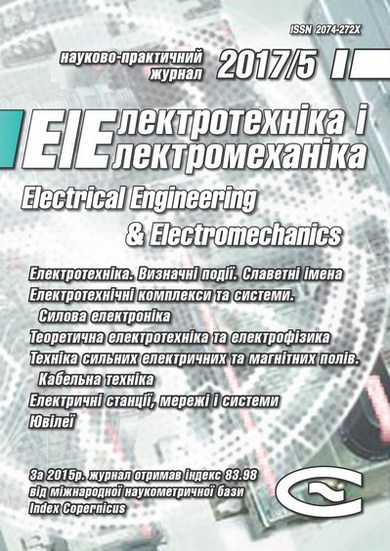AN ACTIVE POWER FILTER AT OPERATION ON THE UNBALANCED AND NONLINEAR LOADS WITH CONTROL BY OPTIMIZATION ALGORITHM
DOI:
https://doi.org/10.20998/2074-272X.2017.5.03Keywords:
search optimization, visual model, three-phase power supply system, reactive power, power active filterAbstract
Purpose is to develop a method for controlling a power active filter based on search optimization using software of Mathlab package and applying this method for balancing and compensating for all components of reactive power in a three-phase system feeding unbalanced linear and nonlinear loads simultaneously. Methodology consists in the development of a visual model of the power supply system that supplies unbalanced and non-linear loads, to the connection points of which a power active filter on IGBT transistors is connected according to a parallel type scheme. We propose an algorithm for calculating the chosen optimization criterion using a visual model, linking the visual model with an optimizing program, and performing a search engine optimization process using an embedded program that implements the deformable polyhedron algorithm. Results lead to an optimal mode, which is characterized by the amplitudes of the control signals of the power active filter control system determined by the search, as well as the initial value of the voltage on the filter energy exchange capacitor. Originality lies in the fact that the proposed method of controlling the operation of the power filter makes it possible to dispense with the construction of a relatively complex filter control system based on Clark's mathematical transformations. Practical value lies in the fact that finding a quasi-steady-state optimal mode of the power supply system with a power active filter is performed automatically in the process of search optimization with a simplified control system. The above principles can be implemented in the microprocessor control system for power active filters.References
1. Acha E., Agelidis V.G., Anaya-Lara O., Miller T.J.E. Power Electronic Control in Electrical Systems. Bodmin, MPG Books Ltd, Cornwall, 2002. 443 p. ISBN 0 7506 5126 1.
2. Zhemerov G.G., Tugay D.V. Components of total electric energy losses power in PQR spatial coordinates. Electrical engineering & electromechanics, 2016, no.2, pp. 11-20. (Rus). doi: 10.20998/2074-272X.2016.2.02.
3. Czarnecki L.S. What is wrong with the Budeanu concept of reactive and distortion power and why it should be abandoned. IEEE Transactions on Instrumentation and Measurement, 1987, vol.IM-36, no.3, pp. 834-837. doi: 10.1109/TIM.1987.6312797.
4. Nabae A., Tanaka T. A new definition of instantaneous active-reactive current and power based on instantaneous space vectors on polar coordinates in three-phase circuits. IEEE Transactions on Power Delivery, 1996, vol.11, no.3, pp. 1238-1243. doi: 10.1109/61.517477.
5. Akagi H., Watanabe E. H. and Aredes M. Instantaneous Power Theory and Applications to Power Conditioning. Wiley-IEEE Press, April 2007. 379 p. ISBN: 978-0-470-10761-4.
6. Akagi H., Kanazawa Y., Nabae A. Generalized theory of the instantaneous power in three phase circuits. Int. Power Electronics Conf., Tokyo, Japan, 1983, pp. 1375-1386.
7. Akagi H., Kanazawa Y., Nabae A. Instantaneous reactive power compensators comprising switching devices without energy storage components. IEEE Transactions on Industry Applications, 1984, vol.IA-20, no.3, pp. 625-630. doi: 10.1109/TIA.1984.4504460.
8. Peng F.Z., Ott G.W., Adams D.J. Harmonic and reactive power compensation based on the generalized instantaneous reactive power theory for three-phase four-wire systems. IEEE Transactions on Power Electronics, 1998, vol.13, nо.6, pp. 1174-1181. doi: 10.1109/63.728344.
9. Yagup E.V. Optimization of the mode of asymmetric three-phase system using an active filter and a modified control algorithm. Bulletin of the National Technical University «KhPI» Series: New solutions in modern technologies, 2016, no.42(1214), pp. 124-128. (Rus). doi: 10.20998/2413-4295.2016.42.20.
Downloads
Published
How to Cite
Issue
Section
License
Copyright (c) 2017 E. V. Yagup

This work is licensed under a Creative Commons Attribution-NonCommercial 4.0 International License.
Authors who publish with this journal agree to the following terms:
1. Authors retain copyright and grant the journal right of first publication with the work simultaneously licensed under a Creative Commons Attribution License that allows others to share the work with an acknowledgement of the work's authorship and initial publication in this journal.
2. Authors are able to enter into separate, additional contractual arrangements for the non-exclusive distribution of the journal's published version of the work (e.g., post it to an institutional repository or publish it in a book), with an acknowledgement of its initial publication in this journal.
3. Authors are permitted and encouraged to post their work online (e.g., in institutional repositories or on their website) prior to and during the submission process, as it can lead to productive exchanges, as well as earlier and greater citation of published work.





